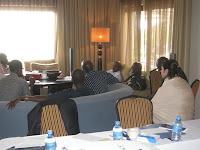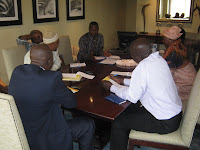
Today, the FRAO/RFP Participatory M&E workshop was inaugurated in Banjul, The Gambia.
The Rural Finance Project in The Gambia (RFP) has organised with the support of the West Africa Rural Foundation FRAO/WARF a Participatory Monitoring and Evaluation (PM&E) training workshop in Banjul from 24 to 29 May 2010.
The objective of the workshop is to reinforce PM&E capacities of project teams and partners engaged in the implementation of IFAD funded projects in the Gambia in including VISACAS, service providers and government. Representatives of the IFAD Country Programme in The Gambia were present as well as representatives from the Ministry of Agriculture, the Microfinance Department of the Central Bank of The Gambia, Gambian Microfinance Associations (GAWFA, NACCUG) service providers and others.

The one week workshop has been set up in a participatory manner so that participants can share their views and learn from each other under the leadership of Mr Mohamed Kebbeh and Mr Adama Ndiaye of WARF who are facilitating the workshop.
Today, participants were able to brainstorm on Participatory Monitoring and Evaluation (PM&E) starting from its definition moving towards its importance in project implementation and the advantages and improvements it will bring to projects in terms of results and impact.
 The lively group agreed that PM&E is a fundamental aspect for project implementation, as PM&E is not just a regular data collection or research activity, instead it increases ownership of the project for its inclusive nature, it gives a sense of accountability of project results to the communities in which interventions are taking place and it could improve project overall activities and outcome.
The lively group agreed that PM&E is a fundamental aspect for project implementation, as PM&E is not just a regular data collection or research activity, instead it increases ownership of the project for its inclusive nature, it gives a sense of accountability of project results to the communities in which interventions are taking place and it could improve project overall activities and outcome.In summary PM&E is a shared learning process based on effective team work, necessary because of the large number of participants, negotiation of interests and possibilities and flexibility as the acceptance of PM&E implies a shift in power relationships because all participants are equal in PM&E.

Finally, PM&E allows for overall better results and gives continuity and sustainability to projects beyond their official life span thanks to beneficiaries designing the system based on criterion they have chosen rather than imposed indicators.
The key steps to PM&E are summarised as follows: (i) deciding to set up a PM&E; (ii) identifying the stakeholders; (iii) defining expectations and objectives; (iv) selecting criteria and indicators; (v) deciding on the tools and methods; (vi) collecting and analysing data; (vii) implementing change and manging and maintaining the system.
How to adapt his model to the context of Gambian projects and managing the system once its in place will be discussed during the course of this training.


0 comments:
Post a Comment